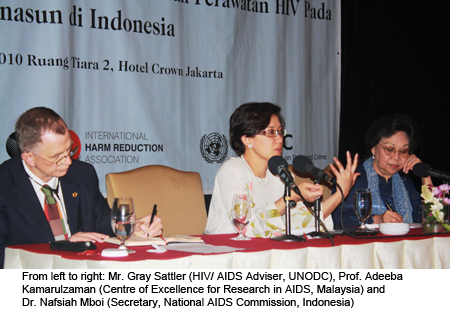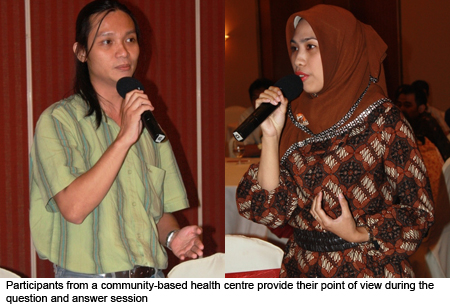Lessons learned from implementing the HIV/AIDS comprehensive harm reduction package in Indonesia

Jakarta (Indonesia), 15 November 2010 - Indonesia has made significant headway in addressing HIV prevention amongst drug users for over a decade. However, injecting drug use is still a major driver of the HIV epidemic, with 57 percent of women and 52 per cent of men who inject drugs living with HIV, the highest national HIV prevalence reported in this population in South East Asia.
On 14 October, representatives from the Government of Indonesia, academia, legal aid societies, international organizations and the United Nations attended a seminar on "Lessons learned from implementing the comprehensive harm reduction package in Indonesia."
Prof. Adeeba Kamarulzaman, from the Centre of Excellence for Research in AIDS, Malaysia, spoke first on the development and implementation of the comprehensive package in Asian countries. The second seminar session looked at the lessons learned from implementing opioid substitution therapy and needle and syringe programmes. This was taken forward into the third session, where representatives discussed the different models of community-based drug dependence treatment supported by the National AIDS Commission, the National Narcotics Board and the Ministry of Social Affairs.
There has been a major effort to scale up of harm reduction services in Indonesia since 2006. Funding to implement HIV prevention, treatment and care is now available to all provinces. The number of needle and syringe programme sites has increased from only four sites in 2003 to 281 sites in July 2010. Of these, 230 are in community-based health centres and 51 are run by non-governmental organizations. Opioid substitution therapy services have also expanded, from two sites in 2004, to 52 sites in 11 provinces, with 2530 patients accessing the services.

Though great progress has been made, more work is needed in order to achieve the goal of universal access to HIV prevention, treatment and care services among men and women who inject drugs.
During his presentation Professor Irwanto, from Atmajaya University, noted that: "Challenges in implementing the comprehensive package in Indonesia may come both from the services provider and/or the clients. Therefore, it is important for the government to scale up human and institutional capacity, investing more in health facilities, implementing the health insurance policy and accelerating people's access to health services".
The final session of the seminar, on HIV and Hepatitis C co-infection, ended with a lively question and answer session during which Doctor Rino from the Cipto Mangunkusumo General Hospital said that: "Liver disease is now the leading cause of death among patients hospitalised with AIDS-related illnesses. The management of hepatitis C in HIV co-infected patients is extremely challenging, as these individuals have additional treatment needs distinct from those infected with either virus alone."
It became clear that participants felt that providing universal access to HIV related services is an area that requires further work. Speaking about the overall usefulness of the seminar a participant concluded that "it gave us a precious opportunity to talk with experts from different disciplines, it was a fruitful experience."
The seminar was arranged by the National AIDS Commission in collaboration with UNODC and co-sponsored by the International Harm Reduction Association.

